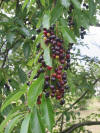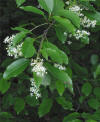WILD
FOODIES' HOME PAGE
PLANT PROFILE LIST
NAME: Black Cherry
SPECIES / FAMILY: Prunus Serotina / Rosaceae
OTHER COMMON NAME(S): rum cherry, mountain black cherry
CONDITIONS: full
sun
|
PARTS: |
EDIBLE |
TASTE |
RAW/COOK |
SEASON |
|
All |
|
|
|
|
|
Shoots |
|
|
|
|
|
Leaves |
||||
|
Stalk/Stem |
|
|
|
|
|
Buds |
||||
|
Flowers |
|
|
|
|
|
Fruits |
|
sweet-bitter |
RAW/DRY/COOK |
Sep |
|
Pods |
|
|||
|
Seeds |
|
|
|
|
|
Nuts |
|
|
|
|
|
Roots |
|
|
|
|
|
Bark |
|
|
|
|
PORTION: small-medium
COMMENT: The fruit is tart, the size of a pea, and used by native Americans. // Fruit - raw or cooked in pies, jellies, stews etc. It must be fully ripe or else it will have a bitter flavour. The fruit can taste sweet or bitter. The better fruits have a thin skin and a juicy flesh with a pleasant vinous flavour. The fruit can also be used as a flavouring. The taste is best when the plant is grown in a sunny position. The fruit is about 9mm in diameter and contains one large seed. Seed - raw or cooked. Do not eat the seed if it is too bitter - see the notes above on toxicity. An infusion of the twigs is used as a beverage. An extract from the bark is used commercially as a flavouring in soft drinks, sweets, syrups and baked goods.(1)
CAUTION: The seeds and leaves of this species contain high quantities of hydrogen cyanide, a poison that gives almonds their characteristic flavour. This toxin is readily detected by its bitter taste. Usually present in too small a quantity to do any harm, any very bitter seed or fruit should not be eaten. In small quantities, hydrogen cyanide has been shown to stimulate respiration and improve digestion, it is also claimed to be of benefit in the treatment of cancer. In excess, however, it can cause respiratory failure and even death. Discard the seeds. Keep plant way from children.(1)
NUTRITION/MEDICINAL: The fruit of the Black Cherry has some 17 antioxidants, including anthocyanins, queritrin and isqueritrin. It is also a rich source of melatonin. The fruit contains Vitamin A, B complex vitamins, Vitamin C, calcium, magnesium, iron, phosphorus, potassium, sodium and traces of copper, selenium, zinc, and cadmium. Unlike the chokecherry, the Black Cherry is a favorite native tree. It has been used for food, woodworking and landscaping. Its inner bark has been concocted for centuries to make a cough syrup.(2) Antidiarrhoeal; Antitussive; Astringent; Pectoral; Sedative; Stomachic; Tonic.(1) Other parts of the plant, especially the leaves, can be poisonous to cattle and other animals.(4)
LOOK-A-LIKES:
POISONOUS LOOK-A-LIKES:
OTHER USES: Dye; Wood. A green dye can be obtained from the leaves. A dark grey to green dye can be obtained from the fruit. Wood - close and straight-grained, light, strong, rather hard, highly shock resistant. It bends well, works well, finishes smoothly, glues well, seasons well, shrinks moderately and is moderately free from checking and warping. It weighs about 36lb per cubic foot and takes a beautiful polish. It is widely used for furniture, cabinet making, the interior finish of buildings etc.(1) Wood also used to smoke meat.
SOURCE LINKS (may include nutritional and medicinal info, plus other uses):
- https://pfaf.org/user/Plant.aspx?LatinName=Prunus+serotina
- http://www.eattheweeds.com/black-cherry-chokecherrys-better-cousin
- https://en.wikipedia.org/wiki/Prunus_serotina
- https://wildadirondacks.org/trees-of-the-adirondacks-black-cherry-prunus-serotina.html
- https://practicalselfreliance.com/prunus-serotina
- https://www.songofthewoods.com/black-cherry-prunus-serotina
- https://gobotany.newenglandwild.org/species/prunus/serotina (good photos)
- https://eattheplanet.org/wild-cherries-a-native-american-necessity
- http://www.suburbanforagers.com/2012/08/20/augustthis-seasons-wild-edible-plant-black-cherries
- https://wildediblesnjpa.com/black-cherry


